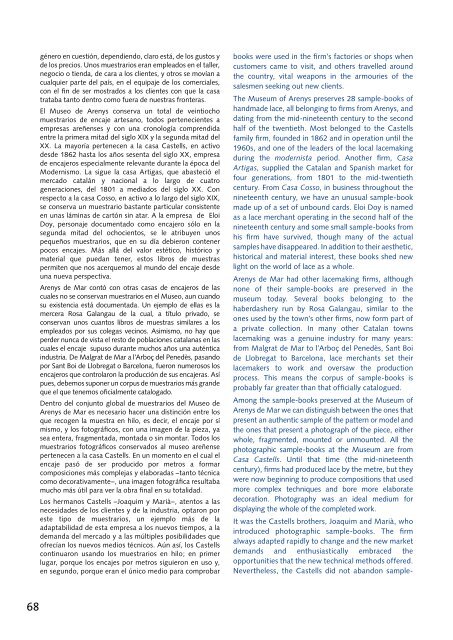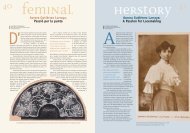Estudi del fons industrial tèxtil de Catalunya.pdf - Joan Miquel Llodrà
Estudi del fons industrial tèxtil de Catalunya.pdf - Joan Miquel Llodrà
Estudi del fons industrial tèxtil de Catalunya.pdf - Joan Miquel Llodrà
Create successful ePaper yourself
Turn your PDF publications into a flip-book with our unique Google optimized e-Paper software.
68<br />
género en cuestión, <strong>de</strong>pendiendo, claro está, <strong>de</strong> los gustos y<br />
<strong>de</strong> los precios. Unos muestrarios eran empleados en el taller,<br />
negocio o tienda, <strong>de</strong> cara a los clientes, y otros se movían a<br />
cualquier parte <strong><strong>de</strong>l</strong> país, en el equipaje <strong>de</strong> los comerciales,<br />
con el fin <strong>de</strong> ser mostrados a los clientes con que la casa<br />
trataba tanto <strong>de</strong>ntro como fuera <strong>de</strong> nuestras fronteras.<br />
El Museo <strong>de</strong> Arenys conserva un total <strong>de</strong> veintiocho<br />
muestrarios <strong>de</strong> encaje artesano, todos pertenecientes a<br />
empresas areñenses y con una cronología comprendida<br />
entre la primera mitad <strong><strong>de</strong>l</strong> siglo XIX y la segunda mitad <strong><strong>de</strong>l</strong><br />
XX. La mayoría pertenecen a la casa Castells, en activo<br />
<strong>de</strong>s<strong>de</strong> 1862 hasta los años sesenta <strong><strong>de</strong>l</strong> siglo XX, empresa<br />
<strong>de</strong> encajeros especialmente relevante durante la época <strong><strong>de</strong>l</strong><br />
Mo<strong>de</strong>rnismo. La sigue la casa Artigas, que abasteció el<br />
mercado catalán y nacional a lo largo <strong>de</strong> cuatro<br />
generaciones, <strong><strong>de</strong>l</strong> 1801 a mediados <strong><strong>de</strong>l</strong> siglo XX. Con<br />
respecto a la casa Cosso, en activo a lo largo <strong><strong>de</strong>l</strong> siglo XIX,<br />
se conserva un muestrario bastante particular consistente<br />
en unas láminas <strong>de</strong> cartón sin atar. A la empresa <strong>de</strong> Eloi<br />
Doy, personaje documentado como encajero sólo en la<br />
segunda mitad <strong><strong>de</strong>l</strong> ochocientos, se le atribuyen unos<br />
pequeños muestrarios, que en su día <strong>de</strong>bieron contener<br />
pocos encajes. Más allá <strong><strong>de</strong>l</strong> valor estético, histórico y<br />
material que puedan tener, estos libros <strong>de</strong> muestras<br />
permiten que nos acerquemos al mundo <strong><strong>de</strong>l</strong> encaje <strong>de</strong>s<strong>de</strong><br />
una nueva perspectiva.<br />
Arenys <strong>de</strong> Mar contó con otras casas <strong>de</strong> encajeros <strong>de</strong> las<br />
cuales no se conservan muestrarios en el Museo, aun cuando<br />
su existencia está documentada. Un ejemplo <strong>de</strong> ellas es la<br />
mercera Rosa Galangau <strong>de</strong> la cual, a título privado, se<br />
conservan unos cuantos libros <strong>de</strong> muestras similares a los<br />
empleados por sus colegas vecinos. Asimismo, no hay que<br />
per<strong>de</strong>r nunca <strong>de</strong> vista el resto <strong>de</strong> poblaciones catalanas en las<br />
cuales el encaje supuso durante muchos años una auténtica<br />
industria. De Malgrat <strong>de</strong> Mar a l’Arboç <strong><strong>de</strong>l</strong> Penedès, pasando<br />
por Sant Boi <strong>de</strong> Llobregat o Barcelona, fueron numerosos los<br />
encajeros que controlaron la producción <strong>de</strong> sus encajeras. Así<br />
pues, <strong>de</strong>bemos suponer un corpus <strong>de</strong> muestrarios más gran<strong>de</strong><br />
que el que tenemos oficialmente catalogado.<br />
Dentro <strong><strong>de</strong>l</strong> conjunto global <strong>de</strong> muestrarios <strong><strong>de</strong>l</strong> Museo <strong>de</strong><br />
Arenys <strong>de</strong> Mar es necesario hacer una distinción entre los<br />
que recogen la muestra en hilo, es <strong>de</strong>cir, el encaje por sí<br />
mismo, y los fotográficos, con una imagen <strong>de</strong> la pieza, ya<br />
sea entera, fragmentada, montada o sin montar. Todos los<br />
muestrarios fotográficos conservados al museo areñense<br />
pertenecen a la casa Castells. En un momento en el cual el<br />
encaje pasó <strong>de</strong> ser producido por metros a formar<br />
composiciones más complejas y elaboradas –tanto técnica<br />
como <strong>de</strong>corativamente–, una imagen fotográfica resultaba<br />
mucho más útil para ver la obra final en su totalidad.<br />
Los hermanos Castells –Joaquim y Marià–, atentos a las<br />
necesida<strong>de</strong>s <strong>de</strong> los clientes y <strong>de</strong> la industria, optaron por<br />
este tipo <strong>de</strong> muestrarios, un ejemplo más <strong>de</strong> la<br />
adaptabilidad <strong>de</strong> esta empresa a los nuevos tiempos, a la<br />
<strong>de</strong>manda <strong><strong>de</strong>l</strong> mercado y a las múltiples posibilida<strong>de</strong>s que<br />
ofrecían los nuevos medios técnicos. Aún así, los Castells<br />
continuaron usando los muestrarios en hilo; en primer<br />
lugar, porque los encajes por metros siguieron en uso y,<br />
en segundo, porque eran el único medio para comprobar<br />
books were used in the firm’s factories or shops when<br />
customers came to visit, and others travelled around<br />
the country, vital weapons in the armouries of the<br />
salesmen seeking out new clients.<br />
The Museum of Arenys preserves 28 sample-books of<br />
handma<strong>de</strong> lace, all belonging to firms from Arenys, and<br />
dating from the mid-nineteenth century to the second<br />
half of the twentieth. Most belonged to the Castells<br />
family firm, foun<strong>de</strong>d in 1862 and in operation until the<br />
1960s, and one of the lea<strong>de</strong>rs of the local lacemaking<br />
during the mo<strong>de</strong>rnista period. Another firm, Casa<br />
Artigas, supplied the Catalan and Spanish market for<br />
four generations, from 1801 to the mid-twentieth<br />
century. From Casa Cosso, in business throughout the<br />
nineteenth century, we have an unusual sample-book<br />
ma<strong>de</strong> up of a set of unbound cards. Eloi Doy is named<br />
as a lace merchant operating in the second half of the<br />
nineteenth century and some small sample-books from<br />
his firm have survived, though many of the actual<br />
samples have disappeared. In addition to their aesthetic,<br />
historical and material interest, these books shed new<br />
light on the world of lace as a whole.<br />
Arenys <strong>de</strong> Mar had other lacemaking firms, although<br />
none of their sample-books are preserved in the<br />
museum today. Several books belonging to the<br />
haberdashery run by Rosa Galangau, similar to the<br />
ones used by the town’s other firms, now form part of<br />
a private collection. In many other Catalan towns<br />
lacemaking was a genuine industry for many years:<br />
from Malgrat <strong>de</strong> Mar to l’Arboç <strong><strong>de</strong>l</strong> Penedès, Sant Boi<br />
<strong>de</strong> Llobregat to Barcelona, lace merchants set their<br />
lacemakers to work and oversaw the production<br />
process. This means the corpus of sample-books is<br />
probably far greater than that officially catalogued.<br />
Among the sample-books preserved at the Museum of<br />
Arenys <strong>de</strong> Mar we can distinguish between the ones that<br />
present an authentic sample of the pattern or mo<strong><strong>de</strong>l</strong> and<br />
the ones that present a photograph of the piece, either<br />
whole, fragmented, mounted or unmounted. All the<br />
photographic sample-books at the Museum are from<br />
Casa Castells. Until that time (the mid-nineteenth<br />
century), firms had produced lace by the metre, but they<br />
were now beginning to produce compositions that used<br />
more complex techniques and bore more elaborate<br />
<strong>de</strong>coration. Photography was an i<strong>de</strong>al medium for<br />
displaying the whole of the completed work.<br />
It was the Castells brothers, Joaquim and Marià, who<br />
introduced photographic sample-books. The firm<br />
always adapted rapidly to change and the new market<br />
<strong>de</strong>mands and enthusiastically embraced the<br />
opportunities that the new technical methods offered.<br />
Nevertheless, the Castells did not abandon sample-



